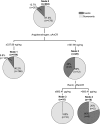Association of elevated urinary concentration of renin-angiotensin system components and severe AKI
- PMID: 24009222
- PMCID: PMC3848399
- DOI: 10.2215/CJN.03510413
Association of elevated urinary concentration of renin-angiotensin system components and severe AKI
Abstract
Background: Prognostic biomarkers that predict the severity of AKI at an early time point are needed. Urinary angiotensinogen was recently identified as a prognostic AKI biomarker. The study hypothesis is that urinary renin could also predict AKI severity and that in combination angiotensinogen and renin would be a strong predictor of prognosis at the time of AKI diagnosis.
Design, setting, participants, & measurements: In this multicenter, retrospective cohort study, urine was obtained from 204 patients who developed AKI after cardiac surgery from August 2008 to June 1, 2012. All patients were classified as having Acute Kidney Injury Network (AKIN) stage 1 disease by serum creatinine criteria at the time of sample collection. Urine output was not used for staging. Urinary angiotensinogen and renin were measured, and the area under the receiver-operating characteristic curve (AUC) was used to test for prediction of progression to AKIN stage 3 or in-hospital 30-day mortality. These biomarkers were added stepwise to a clinical model, and improvement in prognostic predictive performance was evaluated by category free net reclassification improvement (cfNRI) and chi-squared automatic interaction detection (CHAID).
Results: Both the urinary angiotensinogen-to-creatinine ratio (uAnCR; AUC, 0.75; 95% confidence interval [CI], 0.65 to 0.85) and the urinary renin-to-creatinine ratio (uRenCR; AUC, 0.70; 95% CI, 0.57 to 0.83) predicted AKIN stage 3 or death. Addition of uAnCR to a clinical model substantially improved prediction of the outcome (AUC, 0.85; cfNRI, 0.673), augmenting sensitivity and specificity. Further addition of uRenCR increased the sensitivity of the model (cfNRI(events), 0.44). CHAID produced a highly accurate model (AUC, 0.91) and identified the combination of uAnCR >337.89 ng/mg and uRenCR >893.41 pg/mg as the strongest predictors (positive predictive value, 80.4%; negative predictive value, 90.7%; accuracy, 90.2%).
Conclusion: The combination of urinary angiotensinogen and renin predicts progression to very severe disease in patients with early AKI after cardiac surgery.
Figures




References
-
- Chertow GM, Burdick E, Honour M, Bonventre JV, Bates DW: Acute kidney injury, mortality, length of stay, and costs in hospitalized patients. J Am Soc Nephrol 16: 3365–3370, 2005 - PubMed
-
- Ricci Z, Cruz D, Ronco C: The RIFLE criteria and mortality in acute kidney injury: A systematic review. Kidney Int 73: 538–546, 2008 - PubMed
-
- Zhou J, Yang L, Zhang K, Liu Y, Fu P: Risk factors for the prognosis of acute kidney injury under the acute kidney injury network definition: A retrospective, multicenter study in critically ill patients. Nephrology (Carlton) 17: 330–337, 2012 - PubMed
-
- Uchino S, Bellomo R, Goldsmith D, Bates S, Ronco C: An assessment of the RIFLE criteria for acute renal failure in hospitalized patients. Crit Care Med 34: 1913–1917, 2006 - PubMed
-
- Bellomo R, Ronco C, Kellum JA, Mehta RL, Palevsky P: Acute Dialysis Quality Initiative workgroup: Acute renal failure - definition, outcome measures, animal models, fluid therapy and information technology needs: The second international consensus conference of the acute dialysis quality initiative (ADQI) group. Crit Care 8: R204–R212, 2004 - PMC - PubMed
Publication types
MeSH terms
Substances
Grants and funding
LinkOut - more resources
Full Text Sources
Other Literature Sources
Miscellaneous

